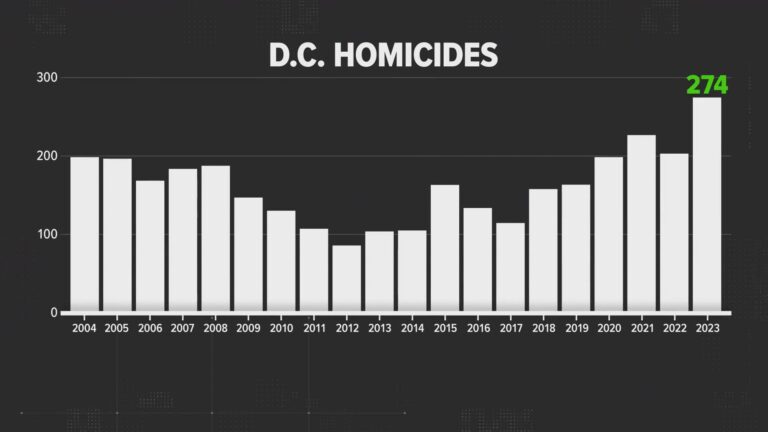Understanding the Escalation of Homicides in Washington, DC: Causes, Impacts, and Solutions
Unpacking the Surge in Violent Crime in Washington, DC
Washington, DC, is currently facing a significant increase in homicide rates, raising critical concerns about the underlying drivers of this violent trend. This escalation is not the result of a single cause but rather a complex interplay of social, economic, and systemic issues. Experts highlight that the rise in gang-related activities and the widespread circulation of illegal firearms are immediate catalysts. However, deeper structural problems such as entrenched poverty, persistent unemployment, and racial inequities in education and healthcare access intensify the crisis. Additionally, historical trauma and a pervasive mistrust of law enforcement within many communities obstruct effective crime prevention and perpetuate cycles of violence, especially in marginalized neighborhoods.
Primary Contributors to the Violence Spike
- Proliferation of unregulated firearms escalating violent confrontations
- Economic marginalization limiting prospects for young residents
- Systemic disparities in housing, education, and healthcare services
- Weak collaboration and communication between police and communities
| Factor | Effect on Violence | Potential Solutions |
|---|---|---|
| Illegal Gun Circulation | Surge in shootings and fatal incidents | Enhanced firearm regulations and focused street-level interventions |
| Socioeconomic Disparities | Crime linked to economic desperation | Employment initiatives and youth development programs |
| Police-Community Disconnect | Reduced cooperation and underreporting of crimes | Community policing and transparency efforts |
Impact on Neighborhoods and Public Safety Obstacles
The uptick in violent crime has profoundly disrupted the fabric of many Washington, DC neighborhoods, particularly those historically underserved. Residents report increased fear and a diminished sense of safety in public spaces, which affects daily routines and community cohesion. This surge has also placed considerable strain on local law enforcement and social service agencies, compelling city leaders to reassess and adapt their approaches. Vulnerable groups, including youth and marginalized populations, bear the brunt of these challenges, often becoming trapped in a reinforcing cycle of poverty and violence.
Barriers to Effective Violence Reduction
- Insufficient funding for outreach and violence prevention initiatives
- Strained police-community relations that undermine trust and collaboration
- Competing priorities in resource allocation between public safety and social equity
| Challenge | Consequences |
|---|---|
| Funding Shortfalls | Cutbacks in prevention and support programs |
| Accountability Issues | Decline in community confidence toward law enforcement |
| Resource Misallocation | Limited effectiveness in crime reduction efforts |
Strategic Responses: Policing and Community Initiatives
To combat the rising homicide rates, Washington, DC authorities have implemented a comprehensive strategy that blends intensified policing with community-based programs. Law enforcement has increased patrols, especially during nighttime hours, in neighborhoods identified as hotspots for violent crime. These efforts aim to deter criminal activity proactively. Simultaneously, targeted operations focus on dismantling gang networks and curbing the illegal arms trade, which are pivotal contributors to the violence.
Alongside policing, the city has expanded community-oriented programs designed to interrupt cycles of violence and engage at-risk youth. Initiatives like Peacekeepers DC collaborate directly with vulnerable populations to mediate disputes and offer alternatives to criminal involvement. Key components of the current strategy include:
- Community Liaison Units: Building bridges between residents and police to foster mutual trust.
- Firearm Surrender Drives: Incentivizing the voluntary relinquishment of weapons to reduce gun availability.
- Anonymous Tip Lines: Providing accessible channels for reporting crime without fear of reprisal.
- Expanded Behavioral Health Services: Tackling underlying trauma and mental health issues linked to violence.
| Approach | Goal | Anticipated Result |
|---|---|---|
| Enhanced Patrols | Crime Deterrence | Decrease in street-level violence |
| Conflict Mediation | Reducing Retaliation | Lower incidence of revenge attacks |
| Gun Buyback Events | Weapon Reduction | Fewer firearms in circulation |
Preventative Measures and Strengthening Community Resilience
Long-term reduction in violent crime hinges on comprehensive prevention strategies that extend beyond policing. Early intervention programs targeting youth at risk are essential, offering mentorship, educational support, and mental health resources. Partnerships among schools, nonprofits, and healthcare providers can create pathways that divert young people from violence and criminal activity. Sustained investment and policy support are critical to ensure these programs achieve meaningful, lasting outcomes.
Building robust local support networks is equally vital. Community-led initiatives such as neighborhood watch groups, accessible social services, and addiction recovery programs foster environments resistant to crime. Addressing fundamental issues like joblessness, affordable housing shortages, and substance abuse can mitigate many of the root causes of violence often overlooked in traditional law enforcement approaches. Below are examples of successful urban programs demonstrating positive impacts:
| Program | Focus | Results |
|---|---|---|
| Mentorship for Youth | Education and Engagement | 30% Decline in Juvenile Offenses |
| Community Conflict Resolution Centers | Dispute Mediation | 20% Reduction in Repeat Violations |
| Workforce Development Programs | Economic Empowerment | 35% Increase in Employment Among Participants |
Conclusion: Moving Toward a Safer Washington, DC
As Washington, DC confronts a troubling rise in violent crime, it is imperative to recognize the multifaceted nature of this challenge. Economic inequality, social fragmentation, and systemic issues within the justice system all contribute to the current homicide surge. Effective solutions require a balanced approach that integrates law enforcement efforts with robust community support and social services. Continued dialogue, data-informed policies, and sustained investment in prevention and intervention programs will be key to reversing this trend and ensuring a safer environment for all residents.







